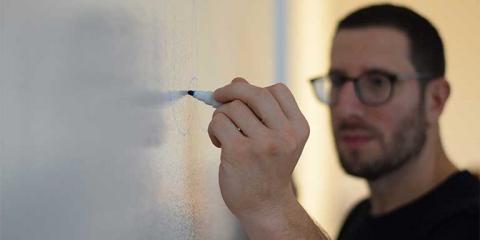Knowing how to use Adobe InDesign opens many job opportunities across a variety of industries. InDesign is used by graphic designers, layout artists, art directors, digital media specialists, book production artists, and freelance designers. Knowing InDesign can help secure a job in these fields. Let’s look at each of these careers in greater detail:
How Graphic Designers use InDesign
A graphic designer creates projects that communicate, inform, and share meaning and brand identity. These include print and digital media, marketing materials, brochures, flyers, signs, displays, and packaging. Assembling text, images, and illustrations into a layout is a common task for graphic designers using InDesign. Because InDesign is one of the most common software applications used for creating layouts, it is often needed for jobs in marketing, advertising, and publishing. According to the US Bureau of Labor Statistics (BLS), the field of graphic design is expected to grow by nearly 250,000 jobs over the next decade, creating a steady demand for graphic designers who are skilled at using InDesign and other digital design tools.
Layout artists using InDesign
Layout artists are responsible for creating and organizing the visual elements of publications such as books, magazines, and newspapers. InDesign is the standard software used by those working in layout artists jobs because it allows them to quickly and efficiently assemble and organize text and graphics on a page. Layout artists also use InDesign to ensure that design and style are consistent throughout a publication, resulting in a cohesive, visually-appealing final publication. InDesign skills are crucial for anyone who wants to become a layout artist. According to Glassdoor, the average base pay for layout artists in the US is around $51,500 per year.
Art Directors and InDesign
Art directors use InDesign to develop visual concepts for advertising and marketing campaigns, create mockups, and make changes to designs in real-time, collaborating with graphic designers and layout artists. The job of an art director is to oversee the visual aspects of a project, such as magazines, movie posters, and product packaging from concept development to product delivery, and InDesign is used in all these projects. InDesign is a critical tool for effective art direction because production artists and graphic designers working under the guidance of an art director are using InDesign. An art director that knows InDesign is able to effectively collaborate on all projects. Because it is a senior level position, there are fewer art directors than graphic designers and production artists. The median salary for art directors is approximately $100,000 per year.
Digital Marketing Specialist using InDesign
InDesign is a valuable tool for digital marketing specialists because it gives provides the functionality necessary for creating templates that can be used for sharing digital media. Digital marketing specialists use InDesign for creating content for online platforms that promotes customer interaction, develops brand loyalty, and drives sales. According to Glassdoor, the average salary for a digital marketing specialist in the United States is around $52,000 per year, while BLS predicts that the number of advertising, promotions, and marketing jobs will grow 10% over the next decade.
Freelance artists use InDesign
Those working in the job of freelancer designer use InDesign to create flyers, brochures, catalogs, and many of the same projects of graphic designers, production designers, and layout artists. There are even freelance art directors. Because freelancers need to share completed work with clients, its important to use digital tools and file formats that are widely used, which includes InDesign. When clients share work to be completed by a freelancer, past projects are often already in the InDesign file format. As such, freelancers need InDesign skills to make updates and revisions, or design similar work.
The fastest path for gaining skills is to attend InDesign classes such as the introductory InDesign course for beginners, or the in-depth InDesign bootcamp. These workshops provide opportunities to quickly learn InDesign so you can start to use your new skills right away at a design related job or career.
